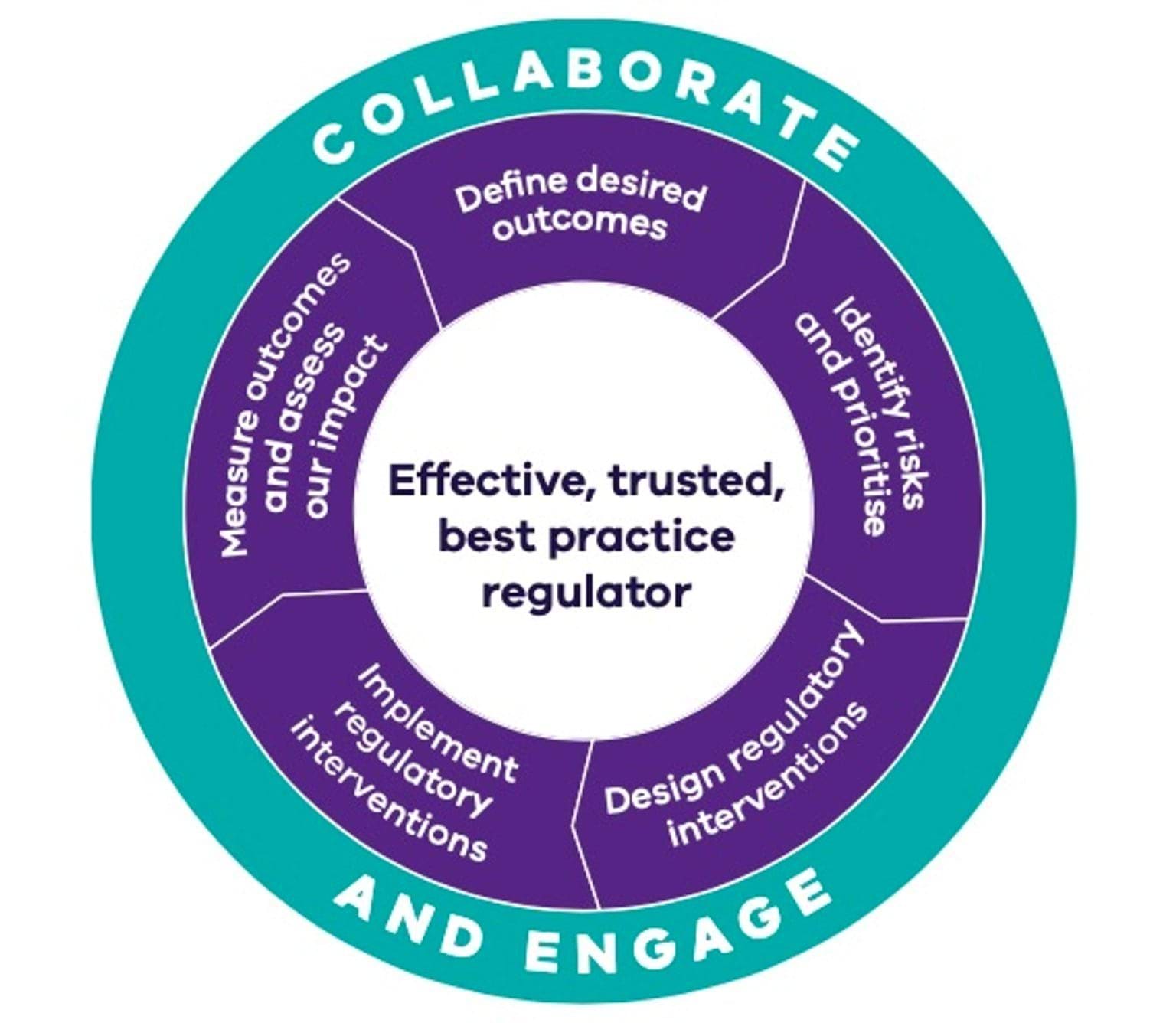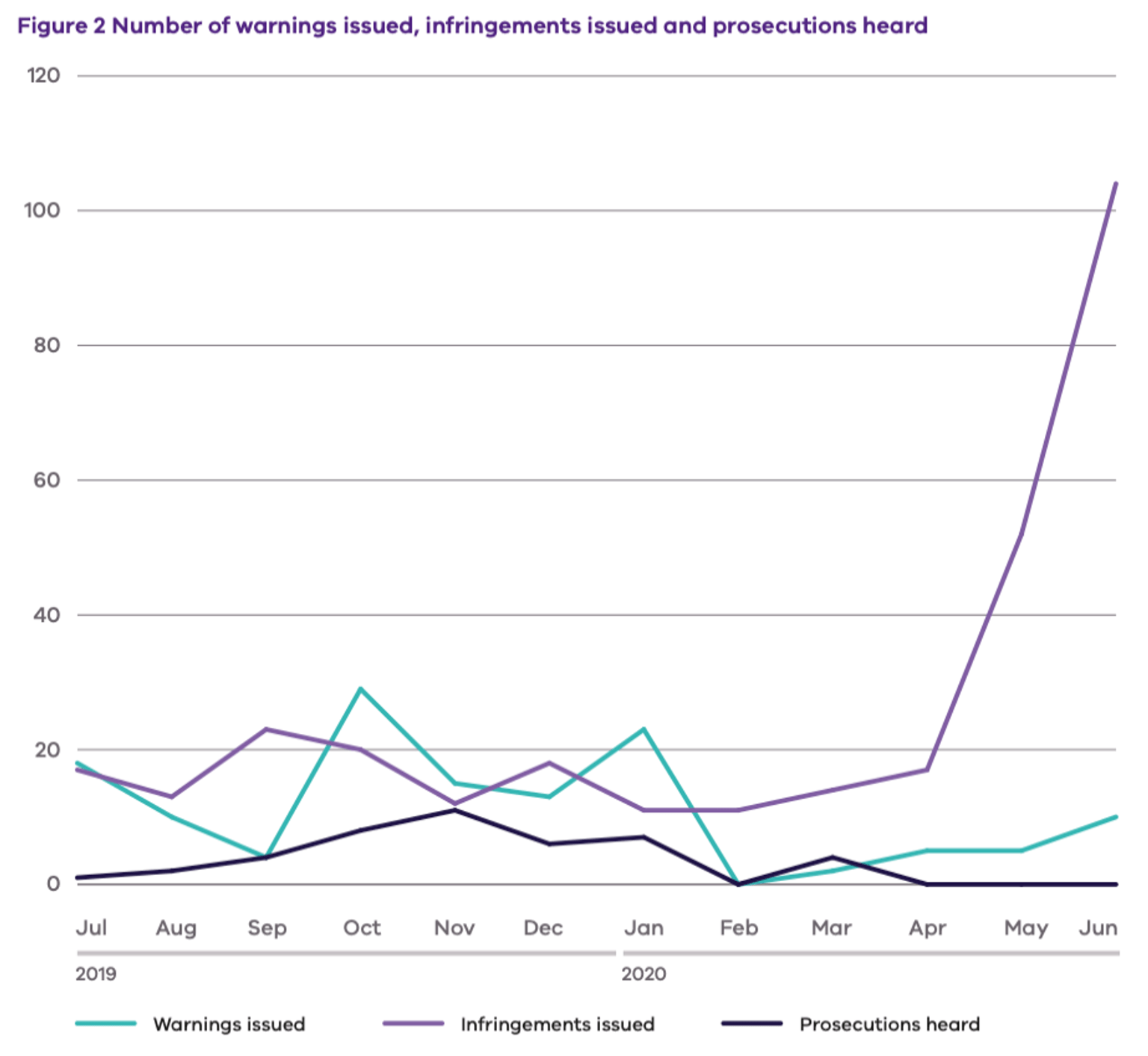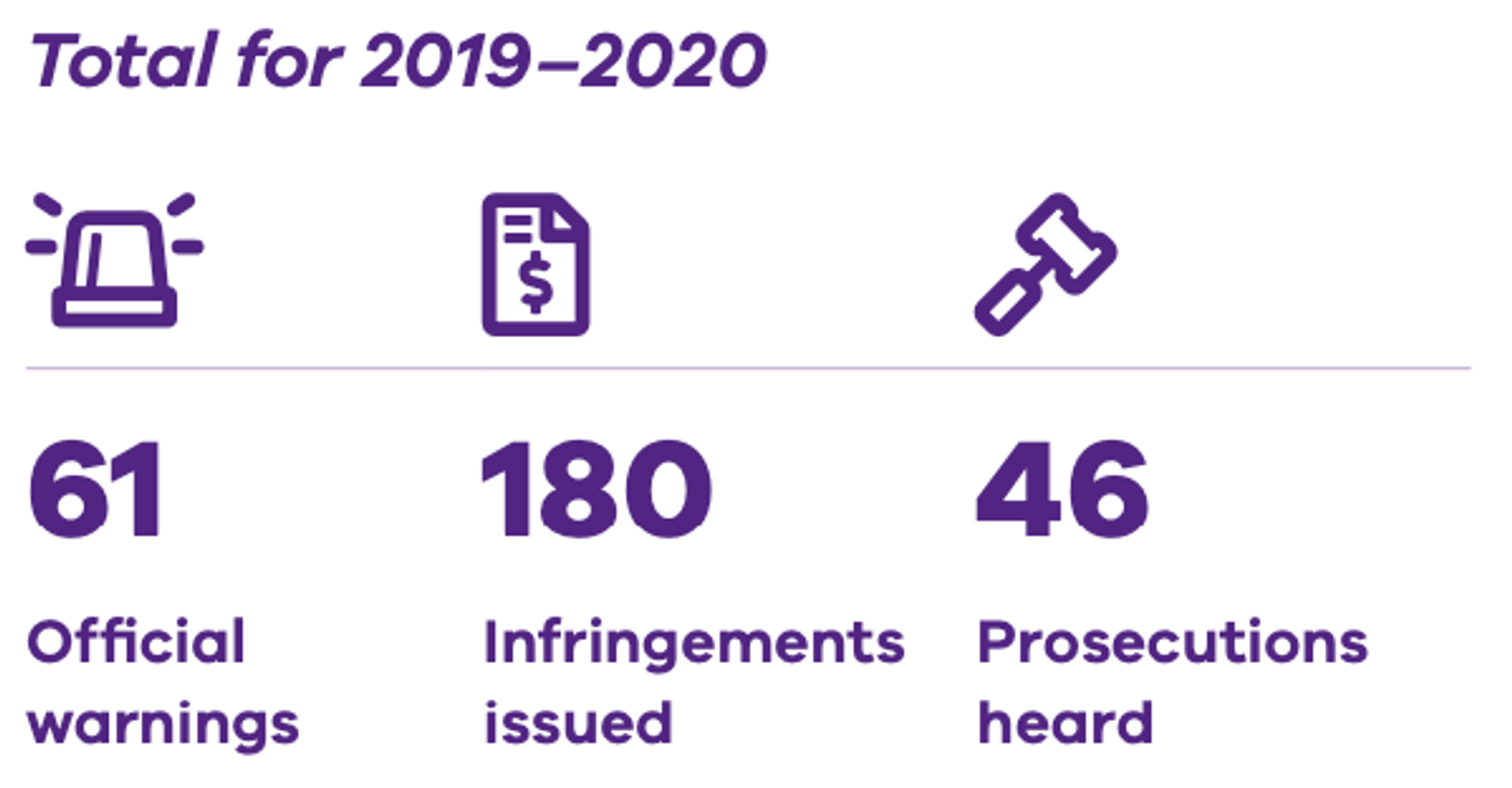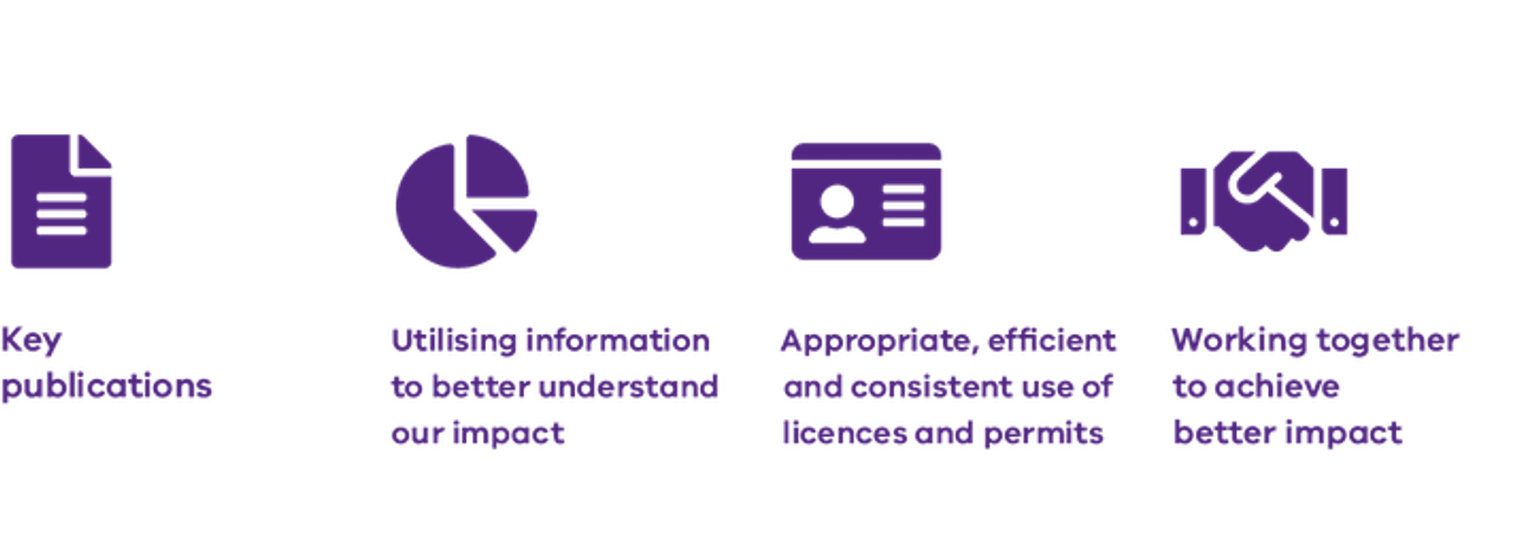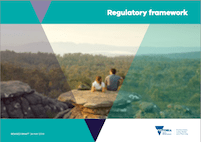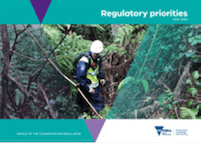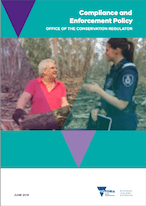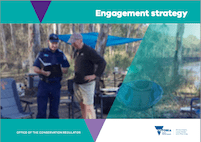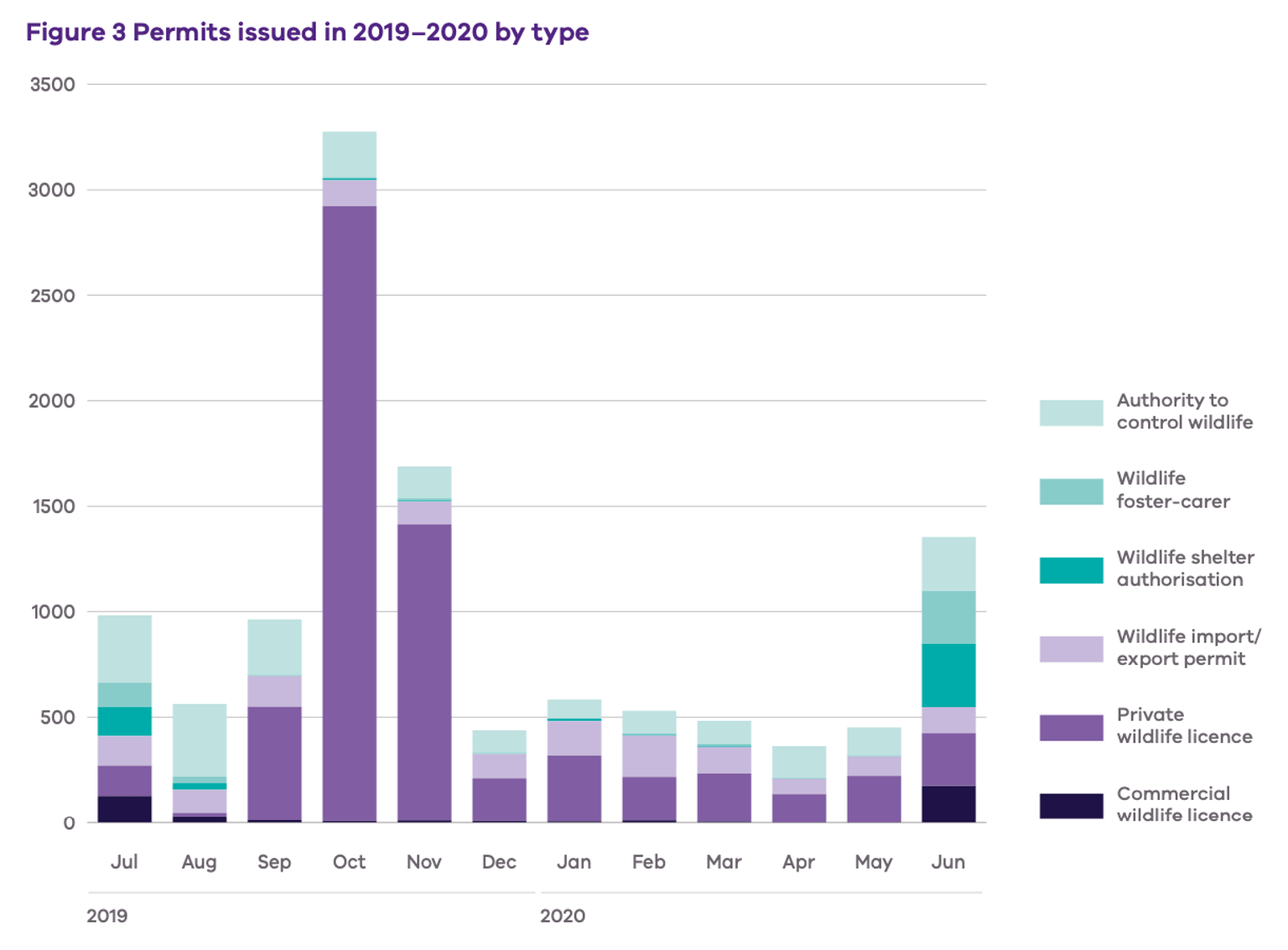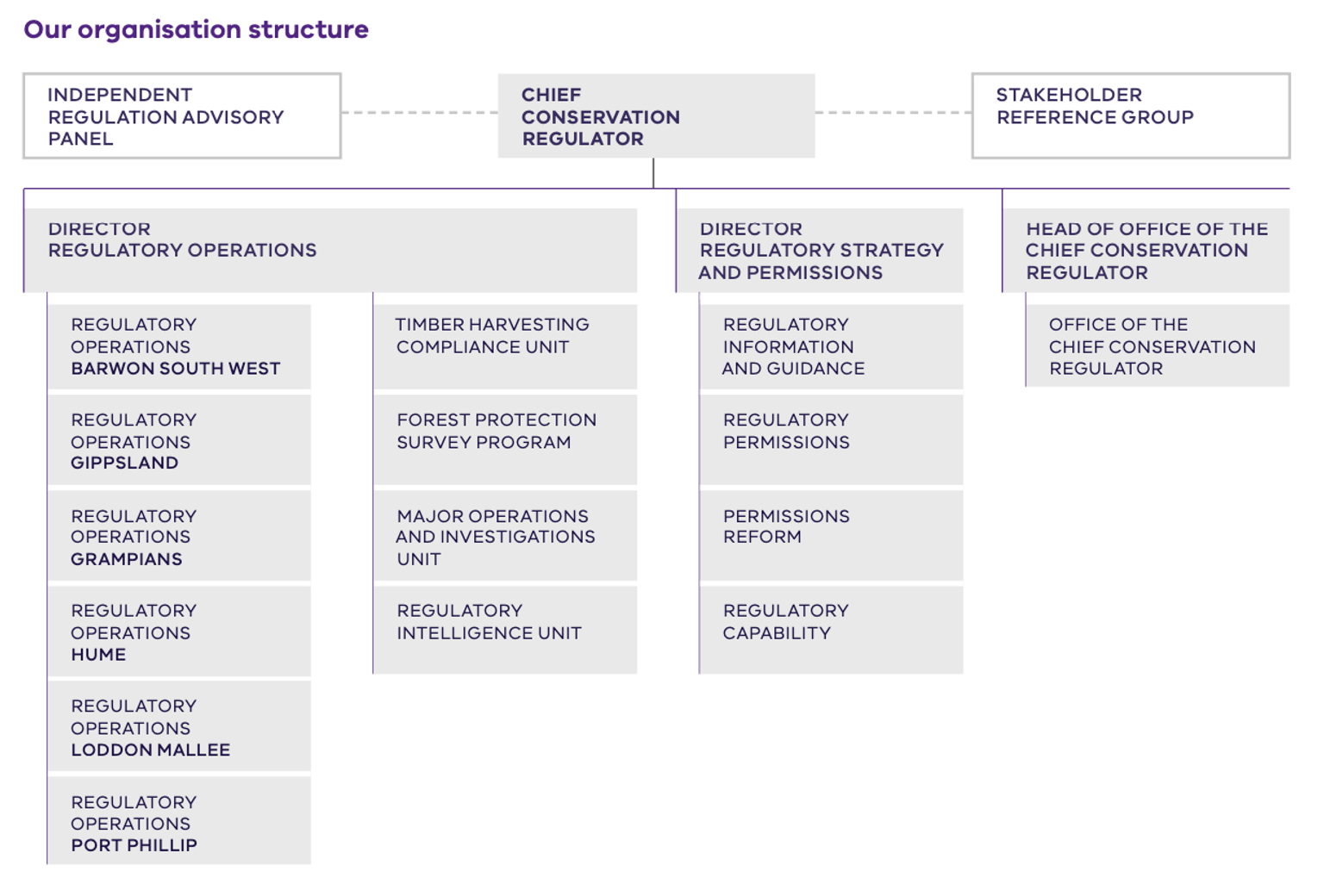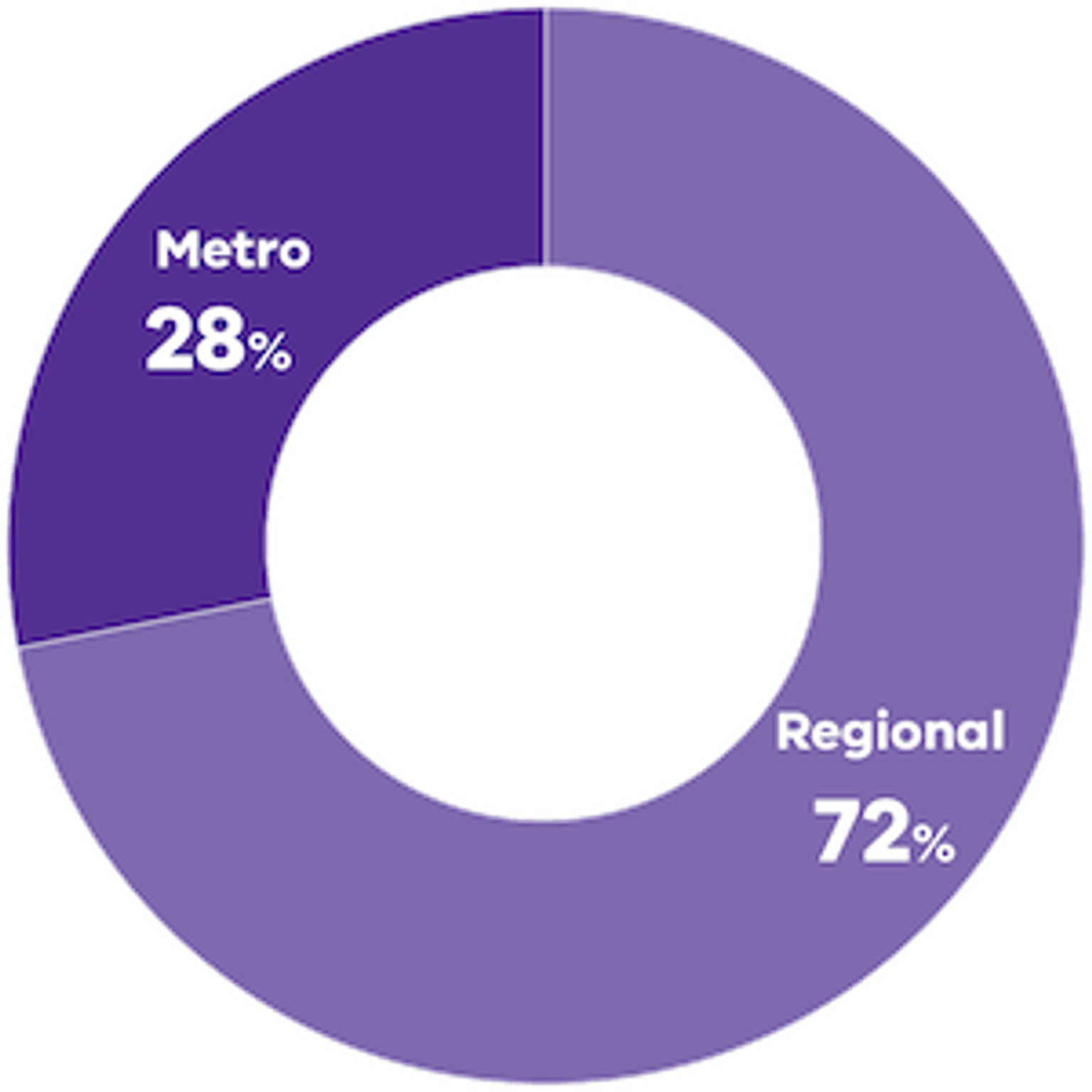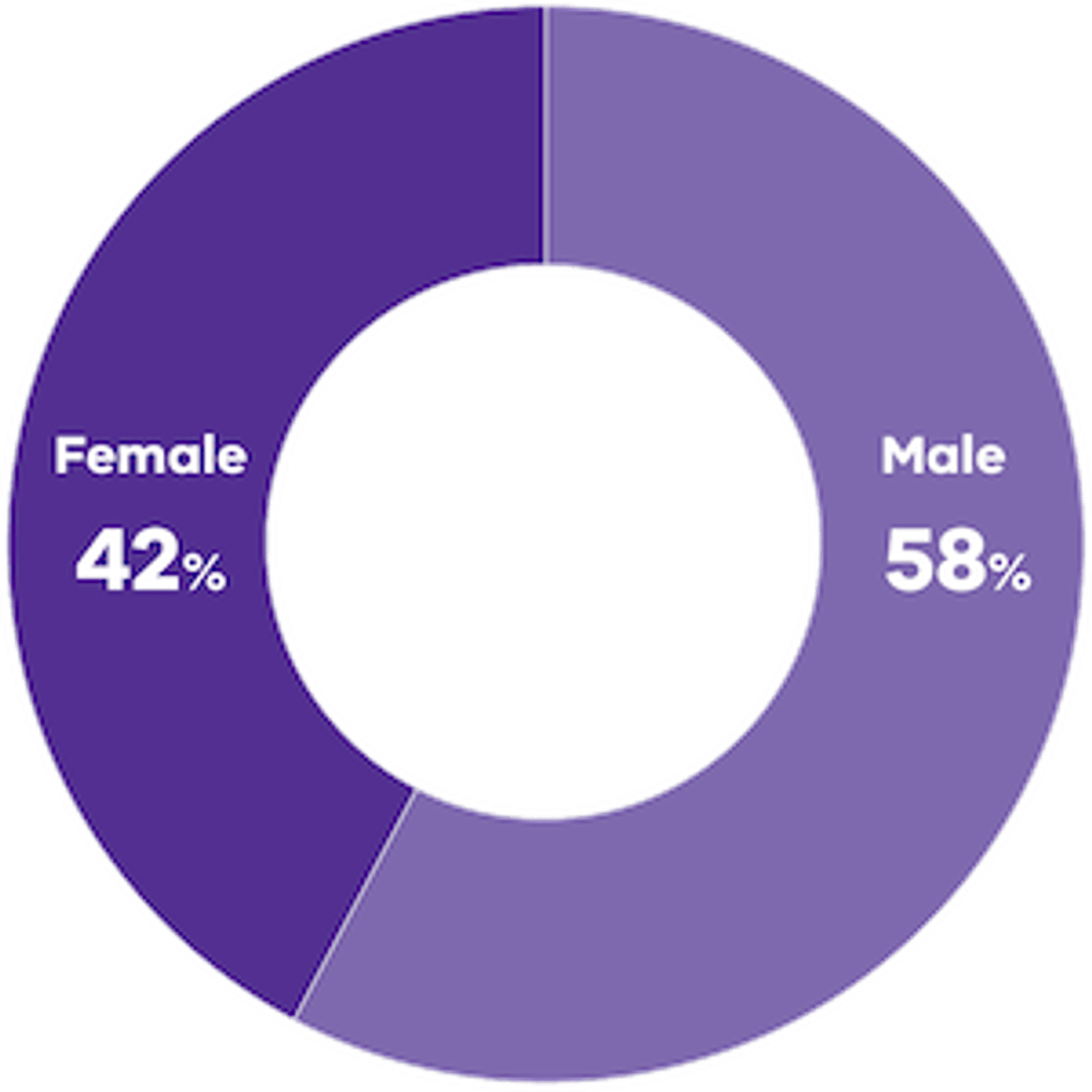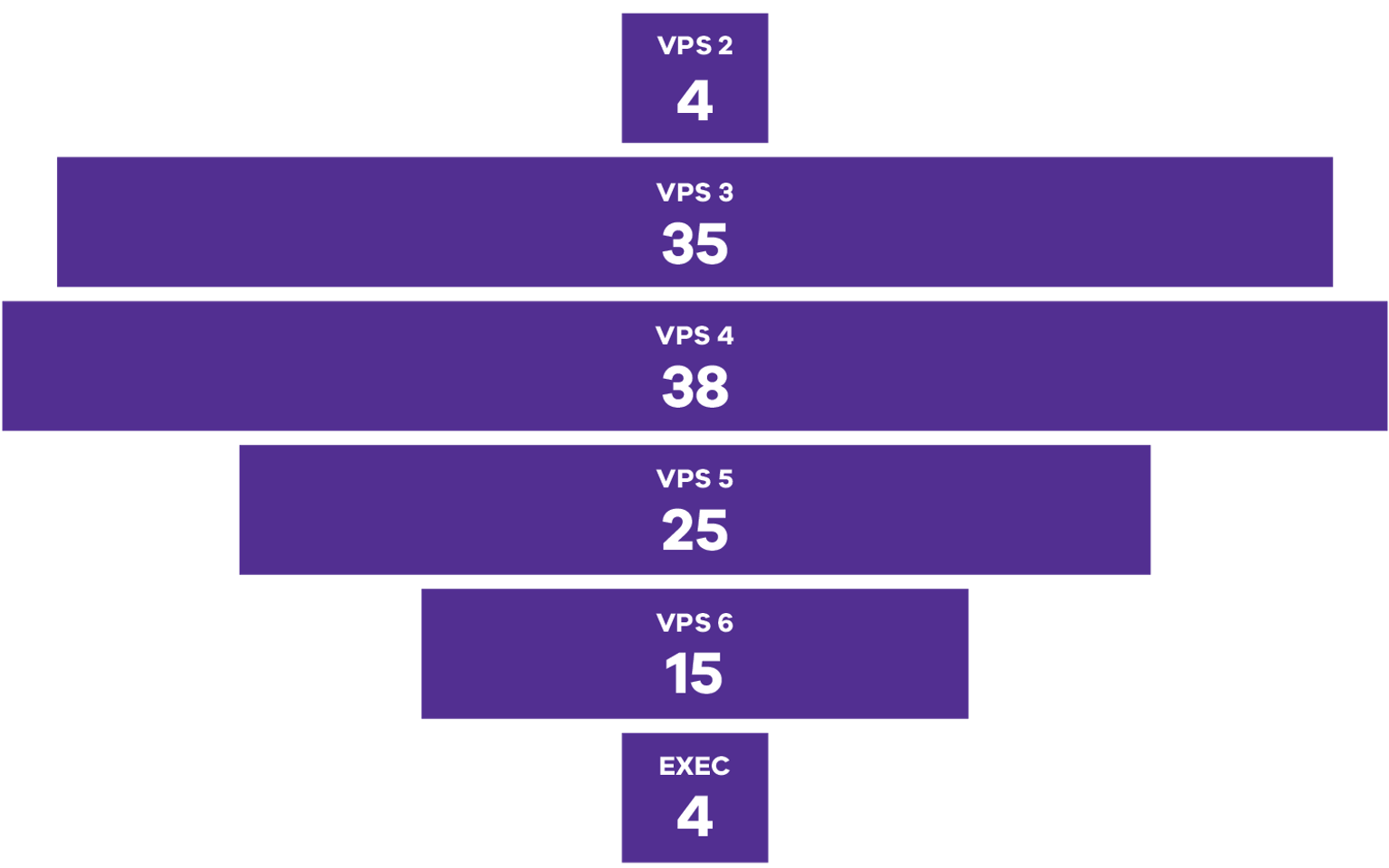- Date:
- 1 Nov 2020
Chief's report
The establishment of the Conservation Regulator is a landmark opportunity to improve our regulatory practices and deliver better protection of our environment, forests and wildlife across Victoria.
Kate Gavens, Chief Conservation Regulator
It has been a significant year, filled with progress across our key regulatory priorities.
An effective, trusted, best-practice regulator.
It is my great pleasure to present the Conservation Regulator’s first Year in Review 2019–2020 and share with the Victorian community the progress we have made in our first full year of operation.
The establishment of the Conservation Regulator is a landmark opportunity to improve our regulatory practices, and deliver better protection of our environment, forests and wildlife for the benefit of everyone in the Victorian community.
As Victoria’s inaugural Chief Conservation Regulator, I am energised by the opportunity to take carriage of this important work, and the willingness of those across the public service, in industry and community to support our regulatory mission of being “an effective, trusted, best-practice regulator”.
As the Conservation Regulator has taken shape, it has been a significant year, filled with progress across our key regulatory priorities, while also being responsive to challenges emerging out of the significant 2019–2020 bushfire season and COVID-19.
I am proud of the flexibility that Conservation Regulator staff have displayed, in both being able to respond to these emerging challenges, while also getting on with progressing our core work.
I would also like to thank our regulatory partners and stakeholders for their investment in the establishment of the regulator through engagement, feedback and partnership. In particular, working with us to tackle these challenges in these unprecedented times.
I look forward to continuing our important work and working with our partners to conserve and protect our environment for future generations.
About us
The Conservation Regulator was established in 2019 to oversee regulatory functions relating to timber harvesting, public land use, biodiversity and fire prevention.
Victoria’s inaugural Chief Conservation Regulator, Kate Gavens, was appointed in early 2019, and is responsible for leading the Conservation Regulator to fulfil its purpose and functions.
Our mission and purpose
At the Conservation Regulator, our mission is:
To be an effective, trusted, best practice regulator.
Our role is to contribute to the delivery of DELWP’s regulatory outcomes including:
- Equitable and safe access to public land and use of natural resources.
- Protected natural and heritage values.
- Sustainable communities – social, economic and environmental.
The Conservation Regulator supports DELWP to lift regulatory performance, works with others in the department and supports the development of systems and capabilities to be an effective and transparent regulator for the Victorian community.
To achieve this, the Conservation Regulator focuses on:
- Collaborating and engaging with the community and with our regulatory partners.
- Regulating in a way that is risk-based and intelligence-led.
- Executing carefully planned and effective regulatory action through applying our regulatory framework, Figure 1.
Our regulatory priorities
In September of 2019, we released our Regulatory Priorities 2019–2020, which outlined our statewide priorities and recognised the unique context and compliance risks facing our regions.
The four state-wide compliance priorities for 2019– 2020 were:
- Illegal campfires
- Illegal take of firewood
- Illegal vehicle use on public land
- Unauthorised timber harvesting in native forests.
Our efforts in our first twelve months of operations have focused on addressing these key priorities, to drive down non-compliance through a combination of education, and compliance and enforcement activities.
Independent review into timber harvesting regulation
In September 2018, the Secretary of DELWP commissioned the Independent Review into Timber Harvesting Regulation 2018 (Review), at the request of the Minister for Energy, Environment and Climate Change, the Hon Lily D’Ambrosio.
The review recommendations went beyond DELWP’s role in timber harvesting regulation to encompass all regulation undertaken by DELWP.
DELWP accepted all recommendations in full and made further commitments in response to the review. Significant progress has been made towards the implementation of the commitments, and progress towards those for which the Conservation Regulator is responsible are summarised in Appendix A.
Progress on our regulatory priorities
There has been significant progress made during the first 12 months of operation, including action taken on, and beyond, the 4 regulatory priorities identified for 2019-2020.
- Illegal campfires
- Illegal take of firewood
- Illegal vehicle use on public land
- Unauthorised timber harvesting in native forests
Illegal campfires
Unattended or poorly constructed campfires are illegal. The warmer months of the year attract large numbers of recreational users to public land. This is at a time of the year when the bushfire risk is elevated.
Lighting a campfire on a day of total fire ban, or burning off without a permit, are illegal and pose serious bushfire risks to the community and to the environment. Our Authorised Officers play an important role in educating the community and monitoring the use of campfires, to make sure campfires are not lit on days of total fire ban and are appropriately constructed and supervised.
Compliance and enforcement action
The devastating 2019–2020 bushfire season affected 1.5 million hectares of land across Victoria and impacted 50 per cent of the modelled habitat of 212 rare or threatened species.
Throughout the season, the Conservation Regulator continued to undertake compliance and enforcement measures to protect the community from bushfires ignited by illegal campfires.
Operation Campfire was implemented across the state, which saw our Authorised Officers from the Conservation Regulator, Parks Victoria, and Forest Fire Management Victoria patrol public land and focus on high risk areas on high fire danger days, to reduce the likelihood of campfires causing bushfires.
In 2019–2020, across Victoria:
- 31 people were prosecuted for a total of 64 offences for lighting a fire on a total fire ban day or allowing a fire to remain alight on a total fire ban day
- 25 infringement notices were issued for illegal campfires
- 19 official warnings were given for leaving a campfire unattended.
Educational activities
Operation Campfire is not only about ensuring compliance but is also about education and raising awareness. Some people may be unaware of restrictions on when and where a campfire can be lit. Through Operation Campfire, we have educated more visitors to our parks about the risks of escaping campfires.
Illegal take of firewood
Population growth, a slowing economy and the increase in energy prices is driving an increase in the illegal collection of firewood. Not only do individuals seek to reduce their energy costs by collecting firewood for their own heating, some individuals take commercial quantities to sell for profit.
Common illegal firewood activities involve felling trees and taking firewood from outside the allocated firewood coupe, or selling firewood taken from Victorian public land.
To ensure the legal collection of firewood, state- wide operations were undertaken in autumn, winter and spring, targeting high-risk locations. This was supported by numerous targeted operations involving field surveillance to investigate and substantiate reports of illegal firewood activities.
Compliance and enforcement action
In March 2020, the Conservation Regulator commenced Operation Hollows with Parks Victoria and Forest Fire Management Victoria, targeting illegal firewood collection across the state. This operation involved a new approach, with a renewed focus on firewood theft across the public land estate.
In 2019–2020, a total of two prosecutions were undertaken with three charges for unauthorised firewood collection, while 41 infringements and 13 warnings were issued.
Strategy development
The Conservation Regulator is continuing to focus on illegal firewood collection. For 2020–2021 we are extending our efforts by adopting new approaches to educating about the laws for firewood collection and, trialling new methods of detecting systemic non-compliance.
Case study: Organised Crime
In May 2018, Project Firefighters in Ballarat observed the removal of firewood they believed had been cut outside a firewood collection area.
The offending included organised and commercial scale illegal felling of trees. Using camouflage and concealment techniques, Conservation Regulator Officers were able to detect and gather evidence of multiple offences.
On 30 April 2019, Officers working with Victoria Police intercepted one of the persons offending in the Ross Creek State Forest. Additionally, Forests Act 1958 and Crimes Act 1958 search warrants were executed at 3 properties in the Smythesdale area. Several items were seized, including 6 vehicles (4 utes, 2 trucks), 10 chainsaws and firewood.
Two offenders were charged on summons in relation to Forests Act 1958 offences. The matters were found proven with convictions, fines, forfeiture of the seized items and 150 hours community corrections order.
Illegal vehicle use on public land
The construction and use of illegal tracks can destroy sensitive habitats of flora and fauna, impacting biodiversity and limiting commercial and recreational access of state forests. There is also a risk of significant injury to users of illegal tracks as they are not maintained.
A key area of risk is non-compliance by trail bike riders particularly in riding off marked tracks. More than 50,000 licensed trail bike riders with registered trail bikes ride recreationally on the 30,500 kms of forest roads and tracks managed by DELWP. Riders also use the road and track network in State and National Parks.
Compliance and enforcement action
In 2019–2020, two prosecutions consisting of 7 offences were undertaken for illegal vehicle use on public land, along with 100 infringements issued and 25 official warnings.
Educational activities
DELWP and the Transport Accident Commission’s Trail Bike Initiative promotes safe, legally compliant, socially and environmentally sustainable trail riding practices.
The core activity is engaging with trail bike riders taking part in eight non-competitive social trail bike rally events conducted on state forest land. In 2019–2020, DELWP Authorised Officers participated in five trail bike events with approximately 2,000 participants.
To promote rider safety, personal locator beacons were awarded to some riders to raise awareness about the value of these devices for signalling and emergency assistance.
Unauthorised timber harvesting in native forests
The Conservation Regulator is responsible for monitoring compliance and enforcing legislation for timber harvesting in state forests. The relevant legislation includes:
- Sustainable Forests (Timber) Act 2004
- Forests Act 1958
- Conservation, Forests and Land Act 1987
- Flora and Fauna Guarantee Act 1988
- Wildlife Act 1975.
The Conservation, Forests and Land Act 1987 provides the legislative basis for the creation and enforcement of the Code of Practice for Timber Production 2014 (the Code), which incorporates the Management Standards and Procedures for timber harvesting operations in Victoria’s State forests 2014 (MSPs).
In June 2019, the Conservation Regulator published the Regulating timber harvesting in State forests under the Allocation Order Statement of Regulatory Intent, which set out a range of actions to improve regulation, as well as performance, and activity measures to monitor performance.
There has been significant focus on timber harvesting in 2019–2020. Our efforts regarding monitoring compliance, education and information, and engagement are outlined in greater detail in Chapter 4 Regulating timber harvesting.
Highlight on illegal activity relating to wildlife
There is strong demand for Australian wildlife on the international black market, and in Australia, there is commercial trade in exotic species by avid hobbyists.
This means that the taking and keeping of wildlife requires scrutiny to reduce the risk of illegal trade.
The Conservation Regulator plays an important role in monitoring the keeping of wildlife to ensure there is no cruelty or mistreatment, as well as investigating the illegal destruction of wildlife.
In 2019–2020, there was a statewide total of:
- 6 prosecutions consisting of 27 offences undertaken for illegal possession and trade of wildlife
- 14 infringements and 39 warnings issued
- 5 prosecutions with 45 charges undertaken for cruelty to or disturbance of wildlife.
Many of these cases are ongoing, and the Conservation Regulator has continued to hold those who offend to account.
Figure 2 shows the number of prosecutions heard, infringements and warnings issued over the 2019–2020 period.
Case study: Wildlife smuggling
Australia’s largest reptile smuggling ring has been disrupted in Victoria by the Conservation Regulator with 36 consignments of wildlife intercepted at the Melbourne Gateway Facility of Australia Post destined for Hong Kong.
The Conservation Regulator worked with Australian Border Force, Department of Environment and Energy, Australia Post and RSPCA Victoria on this operation to investigate the case.
A man had concealed the lizards by packing them into socks inside rice cookers and deep fryers and posting them from Melbourne to addresses in Hong Kong. He pleaded guilty in the Melbourne Magistrates’ Court to 6 charges under the Wildlife Act and 61 charges under the Prevention of Cruelty to Animals Act 1986 in relation to the same animals.
Currently, 4 additional people are before the courts waiting outcomes with one offender currently facing 395 charges for their part in the matter.
The people associated with this aspect of the offending have also been charged in relation to dealing in the proceeds of crime and wildlife related offences.
Nearly 400 surrendered animals from the collection of the main offender are being cared for by Wildlife Officers.
The increases in infringements in May and June relate to increased patrolling of public land following an easing of COVID-19 restrictions. Patrols found a significant increase in illegal use of tracks by trail bikes and unattended campfires.
Our achievements
We have lifted the regulatory performance of DELWP, delivering better regulatory outcomes while driving a more open and transparent approach.
In our first year of operation, we have made significant progress in establishing ourselves as a new regulator. We have lifted the regulatory performance of DELWP, delivering better regulatory outcomes while driving a more open and transparent approach. We have also adopted a more strategic approach to our work, one that focuses our efforts on where the greatest risks lie, and where we can have the most impact. Listed are some of our key initiatives and projects implemented in 2019–2020.
Key publications
The following publications were published since the commencement of the Conservation Regulator in early 2019. These publications communicate our priorities, mission, values and ways-of-working.
DELWP Regulatory Framework
Outlines how DELWP will undertake its regulatory responsibilities and the principles which will guide our approach.
Regulatory Priorities 2019-2020
Presents our first public Annual Regulatory Priorities which outlines the state-wide priorities and recognises the unique context and compliance risks facing the Victorian regions.
Compliance and Enforcement Policy
Describes how the Conservation Regulator will apply the law and exercise judgement and discretion in our compliance and enforcement.
Engagement Strategy
Describes how we will engage with the community, stakeholders, Traditional Owners and co-regulators to deliver regulatory outcomes for the environment and the Victorian community.
Utilising information to better understand our impact
Using the best-available information is essential for us to target our resources to where the greatest risks lie, and to where they will have the most impact. To support this, we have developed:
Monitoring Evaluation and Reporting Framework
To provide accountability and validity of the effectiveness and efficiency of specific regulatory interventions.
Three-year Strategic Intelligence Plan
To better identify and understand how risks and harms to our environment are allowing us to better target our effort to where it will be most effective.
Appropriate, efficient and consistent use of licences and permits
There are many reasons people in our community may need, or want, to interact with native flora and fauna. Some people may wish to keep certain species as pets or for farming, others may need to remove wildlife from their property where they are causing safety or commercial problems.
In circumstances such as these, licences and permits can be granted to allow activity that would otherwise be illegal. Regulatory permissions (licences, permits and authorities) are used to selectively grant permission to conduct an activity which is otherwise illegal.
The Conservation Regulator assesses and decides whether to grant or refuse permissions applications. We also play a role in determining compliance monitoring programs, by assessing compliance levels, and responding to non-compliance.
In 2019–2020, the Conservation Regulator processed more than 11,000 licences and permits. Figure 3 and Table 1 outline the types and volumes of wildlife licences, permits and authorities issued in 2019–2020.
Different permissions types
There are many different permissions relating to environmental conservation in Victoria. They all help to make sure when people do interact with native species, they do it carefully, responsibly and sustainably.
Permissions that the Conservation Regulator is responsible for include:
- Private wildlife licences allow people to keep wildlife as pets.
- Commercial wildlife licences allow for the commercial use of wildlife, including selling wildlife in pet shops, keeping wildlife in zoos, as well as taxidermy and other processing of wildlife products.
- Authorities to control wildlife are for landholders and land managers who have issues with wildlife causing damage to buildings, pasture, crops or other property, or which pose risks to human health and safety. An authority may include permission for lethal or non-lethal control methods.
- Forest produce licences allow individuals and private companies to cut, dig and take away material from state forests for personal or commercial use.
- Research Permits are required for all wildlife in any research capacity, for instance, attaching radio collars to track wildlife, or taking samples from wildlife to better understand genetics.
- Wildlife foster carer licences are required for the care and rehabilitation of injured and orphaned wildlife
Table 1: Total number of licences in 2019-2020
| Licence type | Number |
|---|---|
|
Commercial wildlife licence |
390 |
|
Private wildlife licence |
6580 |
|
Wildlife import/export permit |
1512 |
|
Wildlife shelter authorisation |
505 |
|
Wildlife foster-carer |
449 |
|
Authority to control wildlife |
1990 |
Reforming regulatory permissions
The Conservation Regulator is committed to reforming our licensing and permit systems to make them more efficient, user-friendly and consistent.
In mid-2019, we established a new organisational structure which provides specific resources in each region to support both the efficient processing of permissions, and greater consistency in how permissions are assessed and monitored.
The priority of our permissions reform program is Authorities to Control Wildlife (ATCW). We have been building on the 2019 review of the ATCW system by DELWP’s Biodiversity Division, to guide ATCW reforms.
Work commenced to support the online submission of ATCW applications, and this is expected to go online in 2020–2021.
To support greater consistency across the state in how ATCW applications are assessed, we have improved training and assessment guidelines for assessing officers.
Improved guidance for applicants, along with smoother applications and assessment processes is planned for 2020–2021.
Improvements have also been made to other types of regulatory permissions, including moving from exclusively paper-based to electronic applications and renewals for wildlife licences.
Working together to achieve better impact
Being a successful regulator requires strong relationships with a diverse range of stakeholders from community, industry and our regulatory partners.
The Conservation Regulator published its Engagement Strategy in July 2019 which describes how we will engage with community, stakeholders, Traditional Owners and co-regulators to deliver on our regulatory mission.
We established our Stakeholder Reference Group which meets quarterly and provides advice to the Chief Conservation Regulator on drivers, effective interventions and opportunities.
Partnering with our co-regulators has been a priority to ensure a complementary and coordinated approach to common regulatory risks.
The Conservation Regulator has worked closely with Parks Victoria, the Game Management Authority and Victoria Police throughout the year.
To minimise the impacts to koalas from blue-gum operations, engagement regarding the regulatory approach of koalas in blue gum plantations was undertaken, the outcomes of which will be released in 2020–2021.
We committed to further engagement activities in 2019–2020, however due to COVID-19, some of the face to face engagement activities and education programs planned have been delayed. These activities will be reassessed following the easing of COVID-19 restrictions.
Regulating timber harvesting
We have made significant changes to our regulatory approach including introducing proactive coupe inspections and launching the Forest Information Portal.
Regulating timber harvesting continues to be a key area of focus for the Conservation Regulator.
Enforcement activities and supporting compliance
The Conservation Regulator undertakes a number of activities to monitor and support compliance of timber harvesting operations.
Forest Protection Survey Program
The Forest Protection Survey Program (FPSP) seeks to conduct on-ground surveys to identify the presence of high-value flora and fauna species in coupes that VicForests is proposing to harvest. All scheduled coupes are run through a desktop assessment to prioritise where to conduct surveys.
In 2019–2020, the FPSP exceeded its target of surveying 80 per cent of coupes planned for harvest, reaching 86%. All FPSP survey schedules and results are available publicly on the new Forest Information Portal – a transparent database on information on forest values.
Coupe Inspection Program
This year the Conservation Regulator launched its new Coupe Inspection Program. This new program identifies coupes for compliance inspections based on the presence of important forest values such as waterways, protected plants and animals, and the risks posed to the environment by timber harvesting operations.
The focus in the first year of the program has been on active harvesting operations, harvesting in domestic water supply catchments and pre-harvest inspections of key values. This includes rainforest and exclusion areas set aside for threatened species protections, and operations in or adjacent to forests impacted by fire.
In 2019–2020, 24 field inspections occurred at 16 individual coupes as part of the Coupe Inspection Program. Half of these coupes were inspected multiple times to ensure any identified issues were rectified.
Rainforest Spot Check Program
The Rainforest Spot Check Program uses the most up to data spatial data to determine the extent of possible rainforest vegetation within, and adjacent to, all Timber Release Plan coupes.
Coupes with high value rainforest are prioritised for spot checks to ensure rainforests are appropriately protected from timber harvesting activities.
In 2019–2020, 60 coupes were identified as likely to contain rainforest, with 17 of the highest value located in East Gippsland. Over 65 per cent of coupes identified for rainforest checking were in fire affected areas of East Gippsland. The extensive impacts of the 2019– 2020 bushfire season meant that these areas could not be checked due to post-bushfire safety issues.
This meant 16 coupes were available for spot checking in the Central Highlands. 25% of these coupes received in-field inspections.
Forest Audit Program
The key objectives of the Forest Audit Program were the protection of soil, water and biodiversity values, execution of in-coupe road design and construction, rehabilitation of coupe infrastructure, implementation of forest coupe planning and coupe regeneration.
Through the Forest Audit Program, a proportion of harvested coupes are assessed.
The 2019–2020 Forest Audit Program report is nearing completion and will be published on the Conservation Regulator’s website by early 2021.
Bushfire season 2019–2020
The 2019–2020 bushfires had a significant impact on eastern Victorian forests, including on their unique flora and fauna.
The Conservation Regulator is responsible for ensuring VicForests and its contractors are complying with the Code, including the Precautionary Principle.
We have been working to ensure VicForests understands and responds to its obligations under the law, in particular, the application of the Precautionary Principle in the post-fire environment.
Victorian Forestry Plan
In November 2019, the Victorian Government announced the Victorian Forestry Plan which commits to a gradual phaseout of all logging in native forests by 2030, and an immediate end to logging of old growth forests.
The Victorian Government asked the Conservation Regulator to monitor and publicly report on VicForests’ compliance with the government’s policy to end timber harvesting of old growth forests.
To support compliance with the new government policy ahead of it becoming law, we developed guidance for consistent identification and protection of old growth forests, and the survey methods and data requirements for submitting third-party reports of Greater Gliders.
We also consulted on a Draft Old Growth Forest Field Identification Procedure. The final procedure was developed into two companion documents, an Assessment Tool and Regulatory Guide, which were released in the 2020–2021 financial year.
Collaboration
We receive reports from the community regarding allegations of non-compliant timber harvesting, as well as threatened species and forest values that have been detected in or adjacent to locations where timber harvesting is planned.
The information provided by the community is assessed, and if verified, ensures that in-field forest protections are put in place. In 2019–2020, 56 threatened species reports were carried over from the previous year, 74 new reports were received from the community and 43 reports were assessed and closed.
In 2019–2020, 30 community reports of alleged non-compliance were received with eight reports accepted for investigation. VicForests have been issued with four official warnings and four section 70 directions notices, issued under the Sustainable Forests (Timber) Act 2004. A section 70 notice directs the recipient to modify their harvesting operations to achieve compliance with the Code or a section of the Act.
Relevant information collected in the course of our activities is provided for inclusion in the Victorian Biodiversity Atlas.
Contractors that are commissioned by the Conservation Regulator to undertake verification surveys for threatened species are made aware of their obligations to provide verified and unverified information to the Victorian Biodiversity Atlas. This includes those contractors commissioned through the Forest Protection Survey Program.
The status of forest and threatened species reports, and results of our key performance measures are included in Table 2.
Shared data system
In 2020, DELWP introduced a new more sophisticated shared data system via a mapping platform (the Forest Information Portal) to provide stakeholder access to a wide range of forest related information. This includes results of FPSP surveys and timber harvesting schedules, as well as a variety of recreation, hunting, and forest-related administrative information.
Table 2 Performance measure results for Timber Harvesting Compliance
|
Performance measure |
Target |
Result |
Comment |
|---|---|---|---|
|
Per cent of coupes planned for timber harvesting that have assessments under the FPSP for the potential presence of target flora and fauna, including threatened species and other values such as prescribed vegetation communities and trees |
100% |
100% |
Target achieved |
|
Per cent of coupes planned for timber harvesting that are field surveyed under the Forest Protection Survey Program with a risk of the potential presence for target flora and fauna, including threatened species and other values such as prescribed vegetation communities and trees |
80% |
86% |
Target achieved |
|
Per cent of coupes planned for timber harvesting that may contain rainforest that are spot checked to ensure that VicForests has correctly identified rainforests and has put the required protections in place |
20% |
25%* |
Target achieved |
|
Acknowledge receipt of reports of non-compliance |
<2 work days |
0.9 work days |
Target achieved |
|
Commence the verification of threatened species reports |
<5 work days |
0.5 work days |
Target achieved |
|
Number of coupes harvested in the previous year audited as part of the Forest Audit Program to monitor VicForests’ compliance with the Code and the MSP |
30 |
30 |
Target achieved The Forest Audit Program has consistently audited on average 30 harvest coupes per annum. This was again achieved for 2019–2020. While an additional percentage target sought to double the number of audited coupes per annum, due to unforeseen circumstances, this target was unable to be met. The target will stay consistent at 30 coupes audited per annum from 2020-2021 onwards. |
|
(Per cent of coupes harvested in the previous year audited as part of the Forest Audit Program to monitor VicForests’ compliance with the Code and the MSP) |
(20%) |
(11%) |
|
|
Number of coupes planned for timber harvesting, or in which timber harvesting is underway, that are subject to compliance inspection to monitor VicForests’ compliance with the regulatory framework |
30 |
16 |
The 2019–2020 bushfire season significantly inhibited our ability to undertake inspections therefore this target was unable to be met. A percentage target was a new target for 2019–2020, in future years, the target will stay consistent at 30 compliance inspections per annum. |
|
(Per cent of coupes planned for timber harvesting, or in which timber harvesting is underway, that are subject to compliance inspection to monitor VicForests’ compliance with the regulatory framework) |
(20%) |
(9.6%) |
|
|
Average time taken to investigate alleged or suspected non-compliance |
<12 months |
7.4 months |
Target achieved |
*Coupes in Gippsland and East Gippsland RFA areas were excluded as they were unable to be assessed due to the 2019–2020 bushfires.
|
Activity measure |
Result |
|
Number of threatened species reports received |
74 |
|
Number of threatened species reports that undergo verification |
28 |
|
Number of reports of alleged or suspected non-compliance received |
30 |
|
Number of reports of alleged or suspected non-compliance investigated |
8 |
Our workforce and governance
The Conservation Regulator has more than 120 staff spread across the state providing important services to the Victorian community.
Our organisational structure
The Chief Conservation Regulator leads the Conservation Regulator. There are 3 business units reporting to the Chief.
Office of the Chief Conservation Regulator
Delivering strategic coordination and business management support, and advice to the Chief.
Regulatory Strategy and Permissions Branch
Delivering regulatory policy, strategy, operational procedures, capability development, permissions reform, and statewide wildlife permissions delivery.
Regulatory Operations Branch
Planning and delivering statewide operational programs, including support for and monitoring of compliance, and enforcement of the law.
Our people
Advisory groups
Independent Regulation Advisory Committee
An Independent Regulation Advisory Panel (IRAP) was established in 2019 and comprises three members who are experts in the field of environmental regulation.
The role of IRAP is to provide advice to the Chief Conservation Regulator to support the pursuit of regulatory excellence.
The responsibilities of IRAP include:
- Providing advice to the Chief on best practice regulation
- Providing advice to the Chief on the Conservation Regulator’s settings for regulatory policy and governance, and operational oversight
- Reviewing matters referred to IRAP by the Chief.
Stakeholder Reference Group
The Stakeholder Reference Group includes representatives from environmental non-government organisations, industry, local government and community organisations.
The Stakeholder Reference Group provides advice to the Chief Conservation Regulator on:
- The drivers leading to breaches of regulations
- The design and delivery of an effective mix of regulatory activities to support compliance
- The effectiveness and appropriateness of our communication and engagement approaches
- Opportunities for improvement.
Budget and reporting
The Conservation Regulator is accountable for a significant budget and we have a number of measures which we are required to report against to reflect our impact.
Budget details
Detailed financial reporting was included in the DELWP Annual Report 2019–2020.
In summary, the Conservation Regulator had an annual budget of $20.9 million for 2019–2020 of which:
- $7.8 million was for operational expenses
- $13.1 million was for staffing.
There was no money expended on capital expenses as we utilise shared facilities as part of DELWP.
Performance reporting
The Conservation Regulator reports against four mandatory performance measures from Budget Paper 3. The outcomes of each are summarised in the table below.
Table 3: Budget Paper 3 measures
|
Measure |
Target |
Actual |
Comment |
|---|---|---|---|
|
Investigations of alleged non-compliance with the |
100% |
100% |
|
|
Wildlife Licence renewals processed by target dates |
96% |
95% |
1% below target was due to COVID-19 impacting service delivery |
|
Pre-harvest surveys of areas planned for timber harvesting completed |
80% |
86% |
Appendix A
Progress of the implementation of commitments made in the DELWP Response to the Independent Review into Timber Harvesting Regulation, for which the Conservation Regulator is responsible for delivering.
This does not include commitments and/or recommendations which are the responsibility of other parts of DELWP.
Office of the Conservation Regulator
| Commence establishment of the Office of the Conservation Regulator | Complete |
| Commence recruitment of the Chief Conservation Regulator | Complete |
| Chief Conservation Regulator appointed by 30 May 2019 | Complete |
| Office of the Conservation Regulator formally commences by 30 June 2019 | Complete |
Regulatory framework, policies and guidelines
| Publish Regulatory Framework document | Complete |
| Develop guidance material for Authorised Officers on use and application of available tools across all relevant Acts | Ongoing |
| Publish Compliance and Enforcement Policy | Complete |
| Finalise updated Prosecutions Policy | Complete |
| Publish state and regional Compliance Plans | Complete |
Statement of Regulatory Intent
| Draft Regulating timber harvesting in State forests under the Allocation Order Statement of Regulatory Intent for public consultation | Complete |
| Publish final Regulating timber harvesting in State forests under the Allocation Order Statement of Regulatory Intent | Complete |
| Publish Statement of Regulatory Intent for other areas of regulation | In progress |
| Publicly report on performance against Statements of intent | Complete |
Communications and engagement
| Publish Communications and Engagement Strategy | Complete |
Independent oversight
| Establish Regulation Sub-committee of the DELWP Senior Executive Team | Complete |
| Establish an Independent Regulatory Assurance Panel | Complete |
| Establish a Stakeholder Reference Group | Complete |
Capability development
| Complete Regulatory Capability Assessment | Complete |
| Finalise Capability Development Plan | Complete |
| Community of Regulatory Practice established | Complete |
Shared data system
| System of shared data system for Victorian Government agencies, environmental non-government organisations and VicForests created | Complete |


